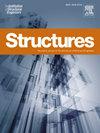Prediction model of maximum stress for concrete pipes based on XGBoost-PSO algorithm
IF 3.9
2区 工程技术
Q1 ENGINEERING, CIVIL
引用次数: 0
Abstract
Due to varying burial conditions and service environments, concrete pipes exhibit complex mechanical behavior. Existing theoretical, simulation, and test methods for determining the maximum stress of pipes have significant limitations, including excessive assumptions, low efficiency, and restricted applicable conditions. Therefore, there is an urgent need to propose a multi-factor associated method for pipe stress prediction. This paper proposed an innovative approach to finely simulate the mechanics response for concrete pipes under the coupling action of stress-seepage-fluid fields. The accuracy of this numerical simulation method was validated through full-scale test. Sensitivity analysis based on Morris sensitivity analysis theory was conducted on traffic load magnitude and speed, buried depth, groundwater table, fluid height and velocity, bedding strength, backfill strength, and pipe diameter. A dataset of “physical variables - maximum stress” for concrete pipes was established. A multi-factor-correlated prediction model of maximum stress for concrete pipe was proposed using XGBoost machine learning method optimized by Particle Swarm Optimization (PSO) algorithm. The results indicate that pipe diameter is highly sensitive; buried depth and traffic load magnitude are sensitive; groundwater table, bedding strength, and backfill strength are moderately sensitive; while fluid height, traffic speed, and flow velocity are insensitive. The XGBoost-PSO model demonstrates the highest accuracy and lowest error compared to BP, RF, and XGBoost models, with improvements in prediction accuracy of 59.6 %, 23.8 %, and 8.6 %, respectively. The model achieves RMSE of 0.118 and MAE of 0.213, demonstrating the suitability of the XGBoost-PSO model for predicting maximum stress for concrete pipes.基于 XGBoost-PSO 算法的混凝土管道最大应力预测模型
由于埋设条件和使用环境的不同,混凝土管道表现出复杂的力学行为。用于确定管道最大应力的现有理论、模拟和测试方法存在很大的局限性,包括假设过多、效率较低和适用条件受限。因此,迫切需要提出一种多因素关联的管道应力预测方法。本文提出了一种创新方法,用于精细模拟混凝土管道在应力场-渗流场-流体场耦合作用下的力学响应。通过全尺寸试验验证了该数值模拟方法的准确性。基于莫里斯敏感性分析理论,对交通荷载大小和速度、埋深、地下水位、流体高度和速度、垫层强度、回填强度和管道直径进行了敏感性分析。建立了混凝土管道的 "物理变量-最大应力 "数据集。采用 XGBoost 机器学习方法,并通过粒子群优化(PSO)算法进行优化,提出了混凝土管道最大应力的多因素相关预测模型。结果表明,管道直径高度敏感;埋深和交通荷载大小敏感;地下水位、垫层强度和回填强度中度敏感;而流体高度、交通速度和流速不敏感。与 BP、RF 和 XGBoost 模型相比,XGBoost-PSO 模型精度最高、误差最小,预测精度分别提高了 59.6%、23.8% 和 8.6%。该模型的 RMSE 为 0.118,MAE 为 0.213,表明 XGBoost-PSO 模型适用于预测混凝土管道的最大应力。
本文章由计算机程序翻译,如有差异,请以英文原文为准。
求助全文
约1分钟内获得全文
求助全文
来源期刊

Structures
Engineering-Architecture
CiteScore
5.70
自引率
17.10%
发文量
1187
期刊介绍:
Structures aims to publish internationally-leading research across the full breadth of structural engineering. Papers for Structures are particularly welcome in which high-quality research will benefit from wide readership of academics and practitioners such that not only high citation rates but also tangible industrial-related pathways to impact are achieved.
 求助内容:
求助内容: 应助结果提醒方式:
应助结果提醒方式:


